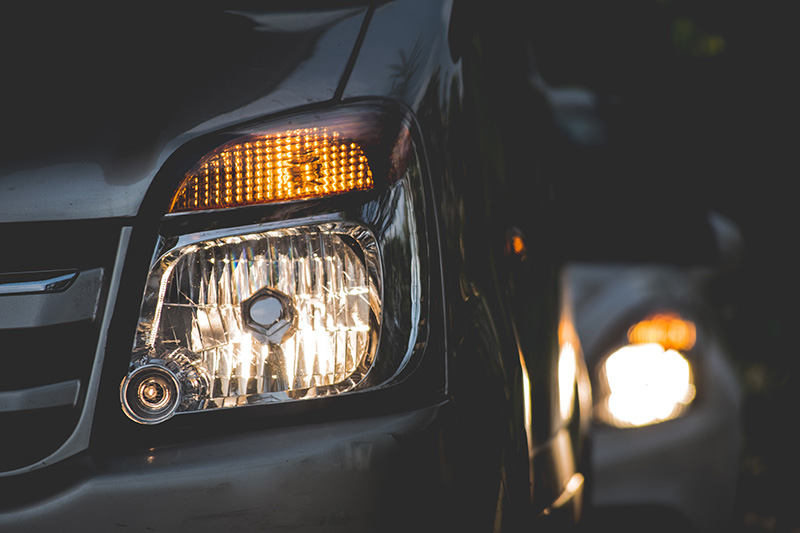
Ultimate Headlight & Fog Light Upgrade Guide
Upgrading Halogen to LED & HID. Reflector vs. Projector style headlights. Improving your existing Halogen, HID, or LED system. 35w vs 55w HID. Finding matching bulb colors. Temperature variations. CAN-BUS Systems. LEDs as DRL. And more! We keep this guide up-to-date with the latest information for upgrading your vehicles lighting systems.


Halogen Bulbs

HID/Xenon Bulbs

LED Kits

Color (Kelvin) Temperature

CAN-BUS
Whether you’re new to the automotive bulb industry, or a seasoned veteran, we hope to help answer all the questions you might have, that we see every day. We’ll break it down into sections, so depending on what type of vehicle you have, what you are looking to do, or are just curious about something, this article should help.
We recommend starting below with Highlight and
Fog Light types, to fully understand why or why you shouldn’t upgrade to one or
the other. However, if you are already familiar, feel free to skip on to Upgrade
Options, our feelings won’t be hurt.
Headlight & Fog Light Types
Reflectors vs Projectors

Reflector Style Headlight
There are two main types of headlight and foglight systems, reflector and projectors. Reflectors were invented back around 1935, but I won’t get into the details there. Don’t let the date fool you though, as today, we still see most brand-new vehicles utilize the great technology. A reflector headlight consists of a bulb installed into a plastic reflective bowl. Mirrors are strategically placed within the headlight to reflect light out onto the roads. The light output and beam depends heavily on the reflective portion and its design, and the newest style reflectors can achieve very good results with a nice cut-off beam pattern, in order to keep glare and dazzle away from oncoming drivers.
You’ll see reflector headlights typically with halogen bulbs, but some come with special HID bulbs, and some even include built-in LED bulbs.
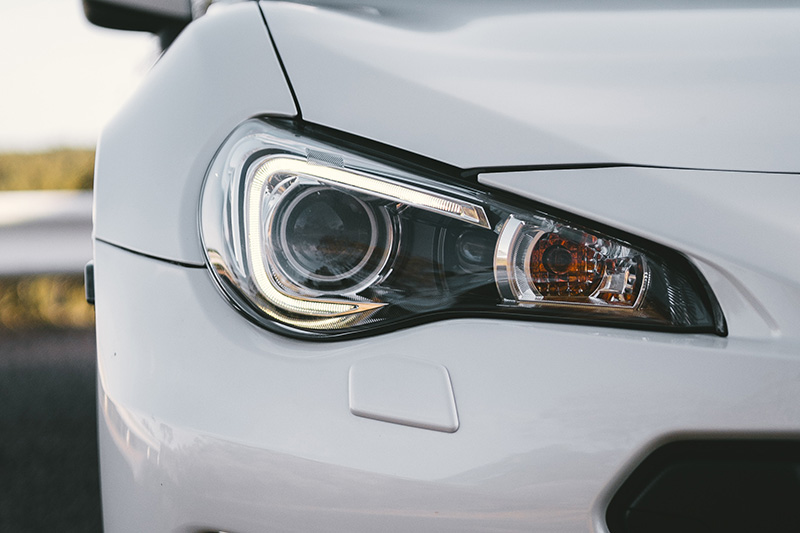
Projector Style Headlight
Projector style headlights were created by Hella back around 1911, however the technology wasn’t widely used until 1989 on the Audi Quartz where it first appeared. Projector technology is a huge improvement over reflective tech., in that it not only produces an improved beam, but there is much less or non-existent ‘glare’, and the light goes a much further distance. If you are buying a new vehicle where there is an optional ‘lighting package’ for an extra cost, typically it includes projector style headlights, and it’s worth the money when you start driving during the night, in inclement weather, at highway speeds, etc.
The projector headlight style comes with all sorts of bulb types, including Halogen, LED, and HID. The two latter are the superior technology. More on that below.
Something to keep in mind is that all headlights, no matter reflector or projector, are specifically designed from the manufacturer’s vendor (ie. Hella) to work perfectly with the headlight assembly or headlamp. When you change the bulb style out or even the intensity of the original bulb, it can change the beam pattern, sometimes in bad ways. We’ll get into the details below and what you should look out for.
Halogen vs HID vs LED vs Laser
Halogen

Halogen bulb technology is the oldest around, but still very widely used not only in
the automotive market, but also household, industrial, etc. Creating a halogen bulb
is cheapest, as the components are very simple compared to the others (HID and
LED). They consist of a glass container or envelope filled with a mixture of
halogen chemicals, with a filament coil, that heats up due to electrical
resistance, and glows. Halogen is the most widely used lighting tech, again due
to the low cost, many manufacturers choose halogen to meet the standards of the
governed regulations such as DOT in the US, ECE in Europe, and so on. It’s the
minimal amount of lighting you can get away with, and most people don’t think
about the lighting that goes into a vehicle during the purchase, until they get
out on the road and night and have visibility issues.
PROS: Cheap, Direct replacement
CONS: Short Life, High Heat, Not as Bright, No option for colors (without sacrificing brightness), Dim over time
Take a look at our latest Halogen bulb Recommendations based on our lab tests
HID/Xenon

HID or ‘Xenon’ bulb emerged in the automotive industry starting in the early 1990’s, however HID (High Intensity Discharge) technology was invented and used long ago in industrial applications. HID bulbs are filled with noble gas and contain special salts, when combined, create an electrical between the electrodes that glow extremely bright, much brighter than a halogen bulb. This tech doesn’t come easy though, HID bulbs require not only a 12v input like Halogen, but also an ignitor and ballast system which are external components which require more space under the hood and sometimes require special mounting for both OE and Aftermarket applications. Another benefit to HID is the lower power consumption they require, typically 35 watts for HID, vs 55 watts for Halogen.
PROS: Extremely Bright, Long Life, Choice of Color, Lower Temps vs. Halogen, Stays bright until failure
CONS: Higher Cost, More components needed, Expensive to replace OE bulbs
Take a look at our latest HID Kit Recommendations and Xenon bulb Recommendations based on our lab tests
LED

LED or ‘Light Emitting Diode’ Technology is the latest and greatest, with a ton of buzz in the automotive industry recently. There are some great qualities, and some bad with LED headlights. First let me say at this point, LED ‘bulbs’ have improved dramatically over the last few years. The chip size and design of the LED system or bulb is very different in 2018 vs. 2015. Just three years ago we wouldn’t have recommended LED, at all, but today, it’s quite the opposite, and recommended, with the proper kit however. I won’t get into all the details on how LED works, but it’s essentially a semiconductor that produces photons through the flow of electrons, that glow very bright. LED by design uses much less power, which results in better power efficiency. This is very useful for household and industrial applications for saving money, but for automotive where the alternator generates power, the benefit comes more from a safety standpoint.
If you have halogen bulbs that double as DRL (or Daytime Running Lights) in either the low beams or high beams, chances are the LED kit your looking to buy won’t turn on as a DRL, but will work when your main beams are on. This is because the range of LED is much more narrow, and doesn’t allow voltage fluctuations as halogen does, ie. ‘not dimmable’. There are some LED kits that we have tested on a 6volt rail that do work as DRLs, and we will list the spec in the full reviews (and in the chart soon).
PROS: Very Bright, Very Low Power, Very Low Temps, Extremely Long Life, Smaller (still require an external driver usually)
CONS: No option for colors (most are 6000k+), DIM over time, Possible Flicker/Errors
Take a look at our latest LED kit Recommendations based on our lab tests
Laser
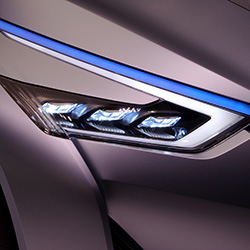
Laser Headlight technology is in it’s infancy as of this article (late 2018), and we won’t get too deep into it as it’s not an option on really any vehicle, nor any aftermarket options. You can probably guess how laser headlights will work, like the laser pointer you may have played with in school, or used during an important presentation, but at a much higher output rate. It’s cool space age stuff, but I’m sure we’ll see it trickle down into the everyday vehicle, just like HID and LED have.
PROS: Up to 1000X brighter than LED while using less power than LED, Over 2X the distance of LED, Very focused beam
CONS: Only recently available in the US on some high-end luxury cars, Expensive
So which is the best technology? Well that answer is subjective, based on what your needs are, how deep your pockets go, how much effort you want to put into your ‘upgrade’, and so on. Read below as we get into application specific recommendations.
Upgrade Options
DISCLAIMER (because we must): You agree to use any and all products listed on this entire website at your own risk. BulbFacts claims no responsibility for injury or death for any type of use of listed products. BulbFacts accepts no liability for any misuse of any headlight, fog light, or lighting product. Certain headlights may be restricted by law for use only in certain conditions such as off-road use only. You must check with your local law enforcement agency prior to making any modifications to your vehicle's lighting systems.
I have Headlights with Halogen Bulbs, what should I do?
This is the #1 question we have seen asked, and you have come to the right place for the answer. So, you want to ‘boost’ your light output? You have some great choices, and it will all depend on how much you’re looking to spend. More money typically means higher light output, as long as you do things right of course, and follow our recommendations here.
As you read above, there are two primary types of headlights, Reflectors and Projectors. We’ll cover both types and show you your options for each. In case you don’t know which you have, go back and read the ‘Reflector vs. Projectors’ section, you’ll know then.
If you are unsure what type of bulbs your vehicle needs, check the Philips Automotive Bulb Guide. It's very comprehensive and up to date: Philips Automotive Bulb Guide
OE/Long-Life Halogen
Sometimes all it takes to improve your light visibility is just a set of fresh halogen bulbs, even cheap ones. If you’re looking for the least amount of work involved, this is the way to go.
Upgraded Halogen
You also have the option to run an ‘upgraded’ set of bulbs. You’re in luck here, as we have tested nearly every halogen kit available on the market. Check out our Halogen Test Results Chart here and be sure to select the headlight type you have. This is the best option without both breaking the bank or veering away from keeping your vehicle legal. If you are concerned with the law, be sure to watch out for ‘off-road use only’ markings on some kits, as they run either a higher than standard wattage, or have a blue coating for a ‘xenon look’ that changes the color too much from OEM (and typically dims the bulb significantly). Light blue coatings are normally not a problem though, such as on many kits to bump the color just a bit giving more of a ‘white’ look vs. ‘yellow’.
On the to remember when ‘upgrading’ your Halogen bulbs, is the life expectancy. OEM or ‘Long-Life’ bulbs are typically used by manufacturers. These bulbs will last years, even a decade or more depending on use, with a rated number of hours of around 1000. The brightest kits like the Sylvania Silverstar Ultra kit is rated closer to 250 hours. You can see how the lifespan will be around ¼. It’s worth the upgrade for most people, but if you won’t want the hassle with changing them out more often, stick with OE/Long-Life.
Upgraded Halogen bulbs are well suited for both low and high beam headlights.
You can find the latest recommendations, reviews, and full charts from our halogen bulb lab test results.
Aftermarket HID (HID Conversion) Kits
HID has been very popular in the aftermarket scene for a while now, but the problem here is that people with Reflector style headlights install these, and they cause a lot of ‘glare’ as the headlights are not designed for the much higher intensity HID technology has to offer. If you have reflectors, stay away from HID. If you are running Projector style headlights, HID can be a very nice upgrade, as most ‘Halogen Projectors’ take very well to HID. Any kit will do, but the better the brand, the longer they will last, the less problems you’ll have, and of course, the brighter they will be. Check out our Aftermarket HID Test Results Chart to find the best kit for your application here. Another benefit to a quality kit like DDM Tuning Plus, Morimoto, etc. is the UV coating they provide. Without this, after time, you may notice some scorching or burn marks on your headlights, results in dim areas, and ultimately ruining your very expensive OEM headlights. It’s worth the extra money to get quality components. Look for UV Coated in the product details when shopping. So you have settled on HID, but what about the wattage options? Well in this scenario, you’ll want to stick with 35w. Why not 55w? Well, 55w (or 50w) although brighter, also runs hotter, which means your bulbs and ballasts won’t last nearly as long, and you have a higher chance (even with UV coating) of scorching your headlights, and again rendering them useless.
I can choose the color, what should I get? The Color or ‘Kelvin Temperature’ is the warmness or coolness of the light output. Rule of thumb is the closer to 4300k, the more light you’ll have out of the bulb. This is just by nature of how the HID bulbs work. That’s not to say that 5000k or 6000k won’t be bright, it just won’t be as bright as a 4500k option. For more details on color temperatures, check out the Color Temperature section below. If you want a OEM look, stick with 4500k, and if you want a ‘pure white’ look, you can venture on into 5000-6000k. Just try to stay away from anything above 6000k, as you’ll lose a lot of light, and it becomes more of a ‘look’ for your assumed show-car, not road worthy vehicle.
CANBUS or Relay? This will depend on your vehicle, and you’ll need to do some research to see whether it requires either or. Some vehicles don’t work well with CAN-BUS as their electrical systems are not powerful enough, and HID flickering happens, and that doesn’t make for a good time. A Relay system includes extra relay fuses that ‘switch’ on/off when the signal of the headlight is sent, so that the power of the HID system can run on its own power. Relays are common in vehicles, and keep electrical currents safe. On the contrary, some vehicles require CAN-BUS and work best with it such as many European makes. This is because their electrical system includes a computer that monitors your lighting system, advising if there is a bulb out so you can go pick up a replacement. Pretty convenient, huh? More on CAN-BUS in the What is CAN-BUS section below.
What about low-beam vs. high beam? Keep the HID kit for your low beams. HID takes time to warm up, which means the peak brightness isn’t reached until at least a few minutes, with maximum brightness of over 5 minutes. Also, when you turn the bulb on and off while it’s hot, it quickly degrades the quality and life.
You can find the latest recommendations, reviews, and full charts from our hid conversion kit lab test results.
LED Kits (LED Bulbs)
LED as we mentioned previously is a very new technology for vehicle headlights but has reached a point where we feel comfortable recommending them. Just be sure to check our LED Test Results Chart to ENSURE you pick up a kit with a good beam pattern. It’s critical to avoid glaring other drivers and causing problems on the road. We are very selective when recommending LEDs, as again, we only want you to run a kit that works well in both reflector and projector headlights. You can see how LED kit’s beam appears in our test reflector and projector housings, and while some work well in a reflector, others may work better in a projector. It’s best again to always check our chart and click on the beam pattern image for a closer view.
The best LEDs are ones with the latest LED Chip technology like CSP (chip scale package, smaller application), such as Lumileds and CREE (at the time of this article). This is critical as these LEDs are very small, and very bright. This is achievable by mimicking the filament of the halogen bulb, essentially making the light glow brightest at the same exact place, down to the mm. Older models are larger, and don’t focus the light properly, making a big impact out on the road. You’ll see some new designs like the Hikari Ultra and Katana kits, that point light even further by scaling the module on one side smaller than the other.
I want to bring up how certain designs take to Reflectors, and others Projectors. You’ll notice a trend on our charts if you look closely. The kits with a large covering or cap near the tip or top, work good in reflector style headlights, but because of the design of projectors, these same bulbs do very poorly as the light is cut-off too soon inside of the projector. The light is not fully utilized, and light is wasted.
Selecting the right color temperature (more on color below) for an LED can be critical when it comes to inclement weather. You will notice that most LED packages range around 6000k, which is by design of the diodes themselves. Some of the brands will add a coating over the diodes to make them appear more white or yellow, however this sacrifices output. 5000k – 6000k LEDs are great for clear weather, however if you live in an area with a lot of snow, rain, etc. then you may be better off sticking with halogen, or at least either finding a set of yellow (3000k) LEDs for your fog lights, or keeping halogen fog lights installed (if applicable). 4300k used to be the prime or ‘best overall’ color as Xenon bulbs would come in this range stock, however newer studies have proven a color of around 5500k is more pleasing to the eye, but with the exception of less visibility in bad weather.
You can find the latest recommendations, reviews, and full charts from our led bulb lab test results.
Reflector headlights will take well to (from worst to best); an upgraded Halogen Kit, a Proper LED kit
Projector headlights work well with (from worst to best); an upgraded Halogen Kit, a Proper LED kit, a quality HID kit
I have Headlights with Xenon Bulbs, what’s the best Xenon Bulb Replacement?
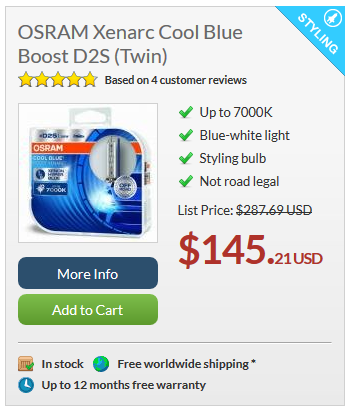
The answer here is quite simple, if you pick up the same fitment type (D1S, D2S, D3S, D4S, etc.), it’ll be a quick swap. These OE Xenon HID bulbs are quite bright, manufactured to specific specification including rare earth salts, which allows them to achieve a specific color and maintaining maximum output.
These bulbs unfortunately DIM over time, just like Aftermarket HID, so it’s a good idea to replace them, even if they haven’t burnt out yet. If you have a bulb that has turned very dim and purple, you can consider that dead, and pretty much useless.
It’s best to stick with the major brands like Philips and OSRAM, however there are some decent and good cheaper alternatives. Very cheap bulbs in the $20 range work too, but the quality including brightness, alignment precision, and longevity will be sacrificed generally.
If you want the same color you had or are just replacing one bulb (it’s best to replace in pairs if possible), then check out what brand you have (typically OSRAM or Philips), and replace it with the same model. We have tested all OEM and upgraded D-Series Bulbs over on our Test Chart here.
You can find the latest recommendations, reviews, and full charts from our xenon bulb lab test results.
Additional Information
Color Temperature
We went into brief detail in the sections above, but if you’re looking for more detail on color temperature known as kelvin, we’ll help clarify some common questions.

The importance of your headlight bulb color should not be ignored. Luckily, OE bulbs and systems are going to be the best ‘overall’ color from the factory. You’ll typically see somewhere from 3300k-5000k, depending on the bulb type and manufacturer.
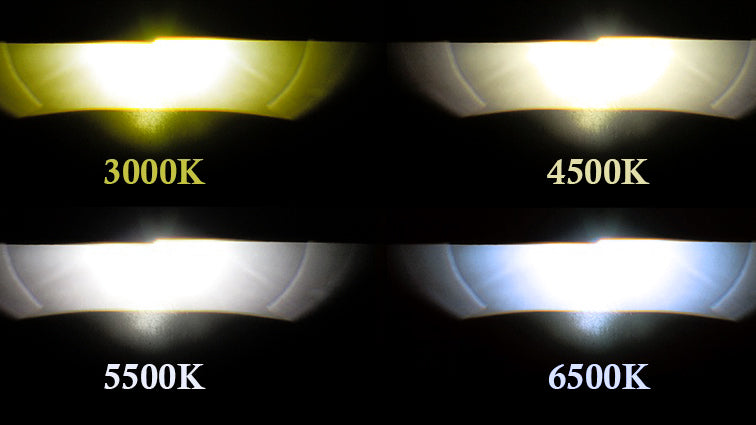
The ideal color for an overall ‘best’ bulb would be around 4300k. This is because a slight hue of yellow helps cut through rain better, as well as snow, sleet, etc. If the color is too yellow however, there is not enough reflection, and the light appears dimmer. If it’s too blue, it bounces off snow and rain much more, as well as road signs, etc., and that can cause too much glare back to the driver of the vehicle. It can also be distracting to other drivers as the bluer light tone appears to be brighter as well. You'll see many new vehicles arrive with whiter LED headlights (when equipped), which seem to be the growing popular choice, as people are looking for a whiter color to meet the demand of more overall clear weather.
At BulbFacts, we consider 5000k ‘pure white’, with no hint of blue. Kelvin can be subjective and relayed differently from different companies. We too the overall average road here. So when you’re looking at our charts and reviews you can keep this in mind. 4000k has a hint of yellow again, and 6000k has a hint of blue.
Luckily, we have tested every bulb for the color, so whether you have LED, HID, or Halogen standard bulbs, and are looking to change your high beams or fog lights, and want to ensure they match in color, just look for your OE bulb to find out the color, and try to match with the new bulb. You can also upgrade with different brands and styles of bulbs to match the colors!
When upgrading your headlight bulbs, try to stay in the ideal range, and you won’t go wrong. For aftermarket applications as well, sticking with ‘OE’ color will draw less attention too, which is a bonus if you’re worried about being cited for your non-DOT approved setup.
What is CAN-BUS? Do I have to worry about it? Can I get around it?

CAN BUS is a vehicle standard adopted by Mercedes in the 1991 W140 model. CANBUS is a very valuable system that allows the computer systems in the vehicle to communicate with each other, including the exterior and interior bulbs. This comes in handy when a bulb is burnt out, especially an exterior bulb like a tail light or head light. The system sees this, and notifies the CANBUS system, in-turn notifying you, the driver.
Where CANBUS can turn into a hassle, is in the aftermarket scene. Because Halogen, HID, and LED all pull power differently, this can confuse the CANBUS system, throwing a false error that you need to check the bulb and replace if needed.
There are add-on options (typically named 'decoder', 'anti-flicker' 'error-eliminator', etc) that can be added to the HID or LED aftermarket products, however some of these kits include a CANBUS compatible controller. Both options essentially ‘trick’ the computer into thinking everything is ok. For some vehicles, you can take them into the dealer and have them change the programming to rid the errors, and there are also products (like VAGCOM VCDS by Ross-Tech for the VWAG vehicles) for example where you can do it yourself.
35W vs 55W HID

We went into this under the Aftermarket HID section, where you’ll see the option most. OE Xenon/HID bulbs are 35w, whereas Halogen bulbs are typically 55w for most sizes. Since HID is much more efficient, it doesn’t pull as much power from the vehicle. Try to stay with the same wattage (or lower, see CANBUS section above), as the vehicle is designed for the specific amount.
If your trying to choose between the two in an HID Kit, check out the Aftermarket HID section above.Retrofit Options
If just swapping out the bulb isn’t enough for you, there is an entirely separate community of people referred to as lighting enthusiasts, which will go the extra mile to get the very best lighting from their vehicle. There are two main ways to accomplish this.
Replacement Aftermarket Headlights
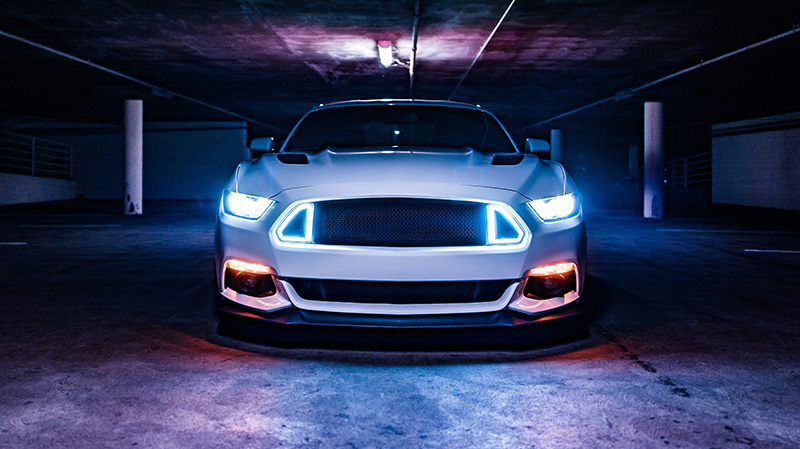
This is the easier of the two, and consists of finding an aftermarket set of headlights, normally a set with projectors. This would be a large upgrade from your stock reflector headlights, as we described above the benefits of using projector headlights. You would need to take the entire headlight assembly out, and swap in the new. You can DIY, or bring your vehicle in to a professional to have this done. The results again are very good, but just be sure swap out the halogen bulbs they typically come with for a good set of HID bulbs and ballasts.
Custom Retrofit Projectors

This is the crème of the crop. The bee’s knees. The very best option you can do. With a custom retrofit, you take apart either the existing headlights, or a set of aftermarket headlights, and manually fit a new set of high-end projectors (such as FR-S, Morimoto, RX350, EVOX-R, etc.). These projectors are ‘re-makes’ of OE Projectors found on vehicles like Lexus for example that work extremely well. So in a sense, you are turning your headlights into those found in a vehicle that has a very strong beam and great output.
The work involved is extensive for a DIY-er and is best left to the professional retrofitters. The cost can run upwards of $1000 or more depending on the quality and how custom you want to get, including halos, switchbacks, and more.
